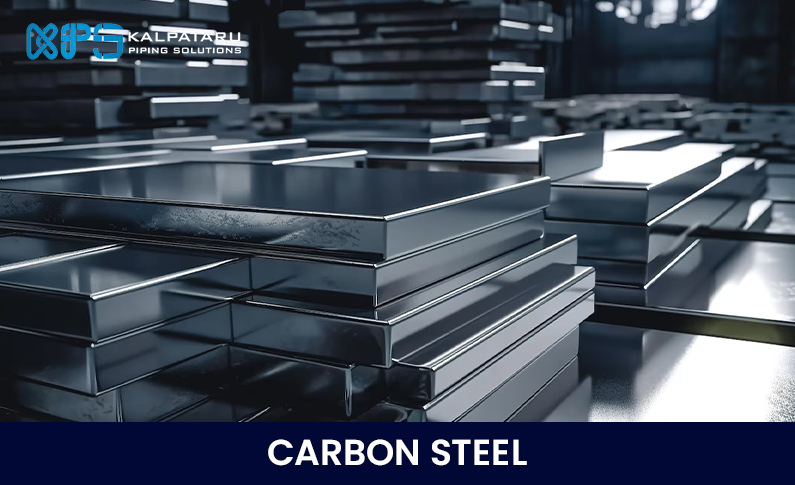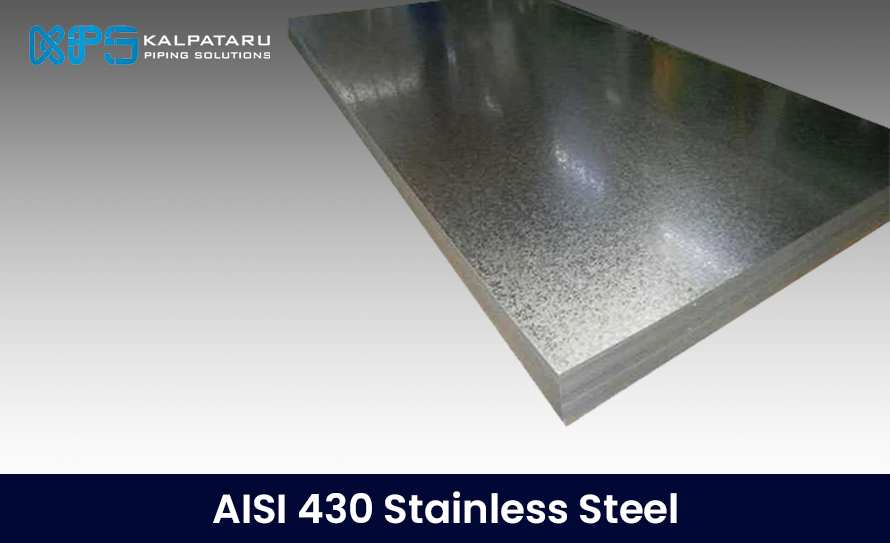Carbon steel is an iron-carbon alloy with up to 2.1 wt.% carbon. It often contains manganese, with a maximum content of 1.65 wt.% for manganese, 0.6 wt.% for silicon, and 0.6 wt.% for copper. Carbon steel composition varies, but it generally includes other elements to enhance its properties.
Types of Carbon Steel and Their Properties
Carbon steel is categorized based on carbon content:
| Type | Carbon Content (wt.%) | Microstructure | Properties | Examples |
| Low-carbon steel | < 0.25 | Ferrite, pearlite | Low hardness and cost. High ductility, toughness, machinability, and weldability | AISI 304, ASTM A815, AISI 316L |
| Medium-carbon steel | 0.25 – 0.60 | Martensite | Low hardenability, medium strength, ductility, and toughness | AISI 409, ASTM A29, SCM435 |
| High-carbon steel | 0.60 – 1.25 | Pearlite | High hardness, strength, low ductility | AISI 440C, EN 10088-3 |
Low-Carbon Steel
Low carbon steel is the most widely used form of carbon metals. It has a carbon content of less than 0.25 wt.% and is not hardenable by heat treatment. It has high ductility, making it excellent for machining, welding, and low-cost applications. High-strength, low-alloy steels (HSLA), classified as low-carbon steels, contain additional elements like copper, nickel, vanadium, and molybdenum, enhancing their properties and corrosion resistance.
Medium-Carbon Steel
Medium carbon steel has a carbon content of 0.25 – 0.60 wt.% and a manganese content of 0.60 – 1.65 wt.%. Its mechanical properties are improved via heat treatment, resulting in a martensitic microstructure. Medium carbon steels have greater strength than low-carbon steels but less ductility and toughness.
High-Carbon Steel
High carbon steel has a carbon content of 0.60 – 1.25 wt.% and a manganese content of 0.30 – 0.90 wt.%. It has the highest hardness and toughness among carbon steels and the lowest ductility. High-carbon steels are very wear-resistant and are often used in cutting tools and die steels, which contain additional alloying elements like chromium, vanadium, molybdenum, and tungsten.
Production and Processing
Carbon steel can be produced from recycled steel, virgin steel, or a combination of both. Virgin steel is made by combining iron ore, coke, and lime in a blast furnace. The molten iron is enriched with carbon, and impurities are removed, resulting in molten steel with roughly 4 wt.% carbon. This carbon content is reduced in a process called decarburization, achieved by passing oxygen through the melt.
Examples & Applications
Low-Carbon Steel:
- Used in automobile body components, structural shapes, pipes, construction, bridge components, and food cans.
Medium-Carbon Steel:
- Used in railway tracks, train wheels, crankshafts, gears, and machinery parts.
High-Carbon Steel:
- Used in cutting tools, springs, high-strength wire, and dies.
Comparison of Properties and Applications of Different Grades
|
Type |
AISI/ASTM Name |
Carbon Content (wt.%) |
Tensile Strength (MPa) |
Yield Strength (MPa) |
Ductility (% elongation in 50 mm) |
Applications |
|
Low |
1010 |
0.10 |
325 |
180 |
28 |
Automobile panels, nails, wire |
|
Low |
1020 |
0.20 |
380 |
205 |
25 |
Pipes, structural steel, sheet steel |
|
Low |
A36 |
0.29 |
400 |
220 |
23 |
Structural |
|
Low |
A516 Grade 70 |
0.31 |
485 |
260 |
21 |
Low-temperature pressure vessels |
|
Medium |
1030 |
0.27 – 0.34 |
460 |
325 |
12 |
Machinery parts, gears, shafts, axles, bolts |
|
Medium |
1040 |
0.37 – 0.44 |
620 |
415 |
25 |
Crankshafts, couplings, cold headed parts |
|
High |
1080 |
0.75 – 0.88 |
924 |
440 |
12 |
Music wire |
|
High |
1095 |
0.90 – 1.04 |
665 |
380 |
10 |
Springs, cutting tools |
Conclusion
In conclusion, carbon steel is a versatile and essential material across various industries. Its classification into low, medium, and high-carbon types allows for tailored properties to meet diverse application needs. With excellent strength, ductility, and cost-effectiveness, carbon steel remains a foundational material in construction, manufacturing, and more. Understanding its composition and properties ensures the optimal selection for specific industrial applications.
FAQs
What is carbon steel?
Carbon steel is a type of steel that contains primarily iron and carbon, with a carbon content typically below 0.35 wt%. It contains only residual amounts of other elements. This composition gives carbon steel its basic properties and applications.
Is carbon steel a good material?
Carbon steel is a good material for certain applications due to its low cost and sufficient strength. However, its susceptibility to rust makes it unsuitable for environments where corrosion resistance is critical. It is ideal for general construction but not for high-precision or high-quality manufacturing operations.
Is carbon steel stronger than steel?
Carbon steel is generally stronger than mild steel due to its higher carbon content. This makes it an excellent choice for applications requiring high strength and hardness. However, carbon steel is also more expensive and less ductile compared to mild steel, and it is prone to corrosion.




